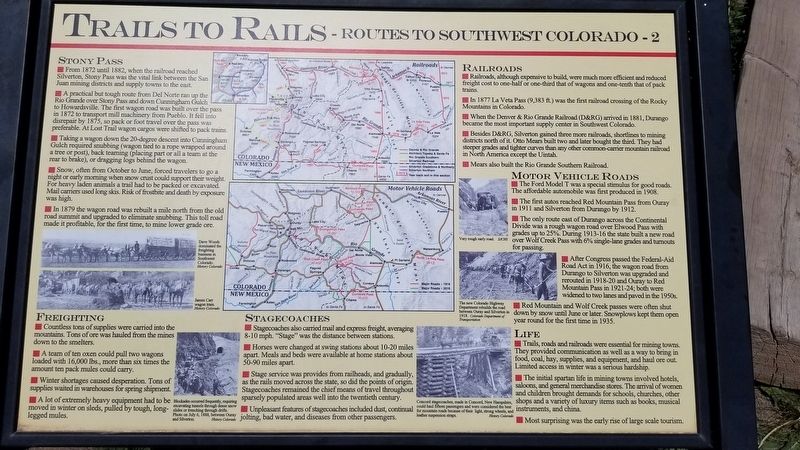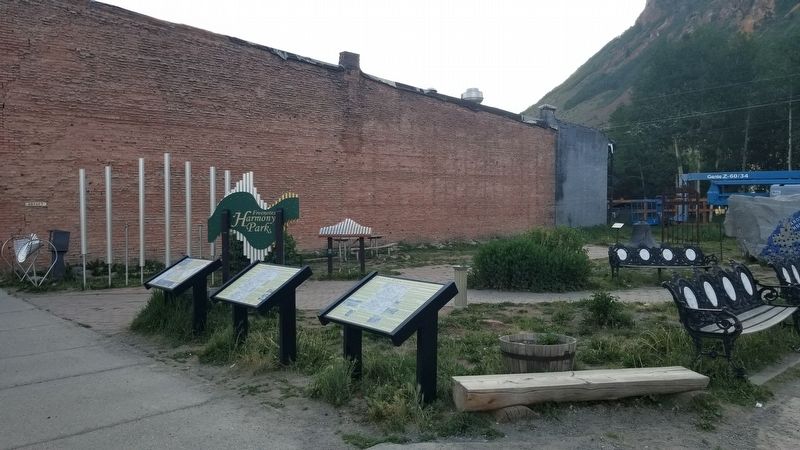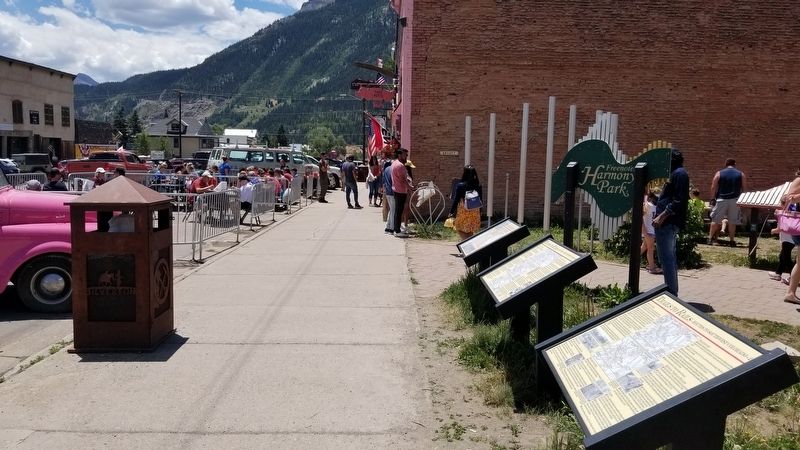Silverton in San Juan County, Colorado — The American Mountains (Southwest)
Trails to Rails
Routes to Southwest Colorado - 2
Stony Pass
▪︎ From 1872 until 1882, when the railroad reached Silverton, Stony Pass was the vital link between the San Juan mining districts and supply towns to the east.
▪︎ A practical but tough route from Del Norte ran up the Rio Grande over Stony Pass and down Cunningham Gulch to Howardsville. The first wagon road was built over the pass in 1872 to transport mill machinery from Pueblo. It fell into disrepair by 1875, so pack or foot travel over the pass was preferable. At Lost Trail wagon cargos were shifted to pack trains.
▪︎ Taking a wagon down the 20-degree descent into Cunningham Gulch required snubbing (wagon tied to a rope wrapped around a tree or post), back teaming (placing part or all a team at the rear to brake), or dragging logs behind the wagon.
▪︎ Snow, often from October to June, forced travelers to go a night or early morning when snow crust could support their weight. For heavy laden animals a trail had to be packed or excavated. Mail carriers used long skis. Risk of frostbite and death by exposure was high.
▪︎ In 1879 the wagon road was rebuilt a mile north from the old road summit and upgraded to eliminate snubbing. This toll road made it profitable, for the first time, to mine lower grade ore.
Freighting
▪︎ Countless tons of supplies were carried into the mountains. Tons of ore was hauled from the mines down to the smelters.
▪︎ A team of ten oxen could pull two wagons loaded with 16,000 lbs., more than six times the amount ten pack mules could carry.
▪︎ Winter shortages caused desperation. Tons of supplies waited in warehouses for spring shipment.
▪︎ A lot of extremely heavy equipment had to be moved in winter on sleds, pulled by tough, long legged mules.
Stagecoaches
▪︎ Stagecoaches also carried mail and express freight, averaging 8-10 mph. "Stage" was the distance between stations.
▪︎ Horses were changed at swing stations about 10-20 miles apart. Meals and beds were available at home stations about 50-90 miles apart.
▪︎ Stage service was provides from railheads, and gradually, as the rails moved across the state, so did the points of origin. Stagecoaches remained the chief means of travel throughout sparsely populated areas well into the twentieth century.
▪︎ Unpleasant features of stagecoaches included dust, continual jolting, bad water, and diseases from other passengers.
Railroads
▪︎ Railroads, although expensive to build, were much more efficient and reduced
freight cost to one-half or one-third that of wagons and one-tenth that of pack trains.
▪︎ In 1877 La Veta Pass (9,383 ft.) was the first railroad crossing of the Rocky Mountains in Colorado.
▪︎ When the Denver & Rio Grande Railroad (D&RG) arrived in 1881, Durango became the most important supply center in Southwest Colorado.
▪︎ Besides D&RG, Silverton gained three more railroads, shortlines to mining districts north of it. Otto Mears built two and later bought the third. They had steeper grades and tighter curves than any other common-carrier mountain railroad in North America except the Uintah.
▪︎ Mears also built the Rio Grande Southern Railroad.
Motor Vehicle Roads
▪︎ The Ford Model T was a special stimulus for good roads. The affordable automobile was first produced in 1908.
▪︎ The first autos reached Red Mountain Pass from Ouray in 1911 and Silverton from Durango by 1912.
▪︎ The only route east of Durango across the Continental Divide was a rough wagon road over Elwood Pass with grades up to 25%. During 1913-16 the state built a new road over Wolf Creek Pass with 6% single-lane grades and turnouts for passing.
▪︎ After Congress passed the Federal-Aid Road Act in 1916, the wagon road from Durango to Silverton was upgraded and rerouted in 1918-20 and Ouray to Red Mountain Pass in 1921-24; both were widened to two lanes and paved in the 1950s.
▪︎ Red Mountain and Wolf Creek passes were often shut down by snow until June or later. Snowplows kept them open year round for the first time in 1935.
Life
▪︎ Trails, roads and railroads were essential for mining towns. They provided communication as well as a way to bring in food, coal, hay, supplies, and equipment, and haul ore out. Limited access in winter was a serious hardship.
▪︎ The initial spartan life in mining towns involved hotels, saloons, and general merchandise stores. The arrival of women and children brought demands for schools, churches, other shops and a variety of luxury items such as books, musical instruments, and china.
▪︎ Most surprising was the early rise of large scale tourism.
Captions
Lower left, top: Dave Woods dominated the freighting business in Southwest Colorado. History Colorado
Lower left, middle: James Carr wagon train. History Colorado
Lower left, bottom: Blockades occurred frequently, requiring excavating tunnels through dense snow slides or trenching through drifts. Photo on July 6, 1888, between Ouray and Silverton. History Colorado
Lower right, top: Very rough early road. SJCHS
Lower right, middle: The new Colorado Highway Department rebuilds the road between Ouray and Silverton in 1918. Colorado Department of Transportation
Upper right, bottom: Concord stagecoaches, made in Concord, New Hampshire, could haul fifteen passengers and were considered the best for mountain roads because of their light, strong wheels, and leather suspension straps. History Colorado
Erected by Durango Railroad Historical Society.
Topics. This historical marker is listed in this topic list: Railroads & Streetcars. A significant historical year for this entry is 1872.
Location. 37° 48.697′ N, 107° 39.878′ W. Marker is in Silverton, Colorado, in San Juan County. Marker is at the intersection of Greene Street (County Highway 110) and West 12th Street, on the left when traveling north on Greene Street. The marker is located in the front of the Silverton City Park. Touch for map. Marker is at or near this postal address: 1157 Greene Street, Silverton CO 81433, United States of America. Touch for directions.
Other nearby markers. At least 8 other markers are within walking distance of this marker. A different marker also named Trails to Rails (here, next to this marker); Silverton's Railroads (here, next to this marker); 1157 Greene (a few steps from this marker); Liberty Bell? (a few steps from this marker); 1200 Greene (within shouting distance of this marker); 1219 Greene (within shouting distance of this marker); Silverton Standard (within shouting distance of this marker); Historic Site in Journalism (within shouting distance of this marker). Touch for a list and map of all markers in Silverton.
More about this marker. There is a duplicate of this marker at the Durango Train Station in Durango Colorado
Credits. This page was last revised on August 2, 2021. It was originally submitted on August 2, 2021, by James Hulse of Medina, Texas. This page has been viewed 119 times since then and 10 times this year. Photos: 1, 2, 3. submitted on August 2, 2021, by James Hulse of Medina, Texas.


